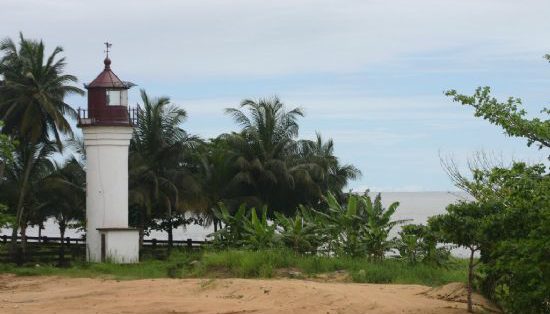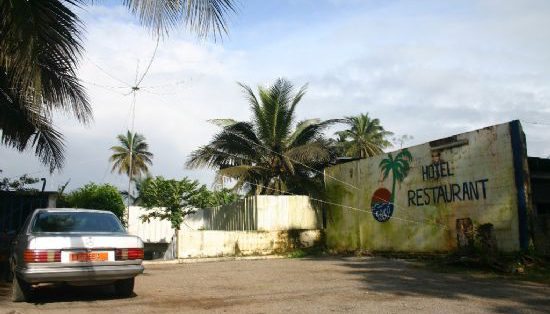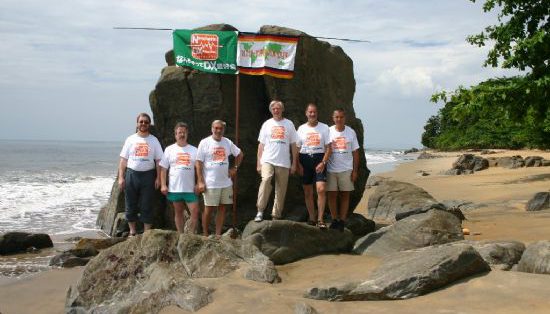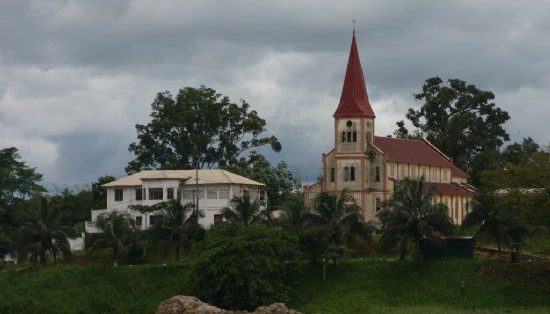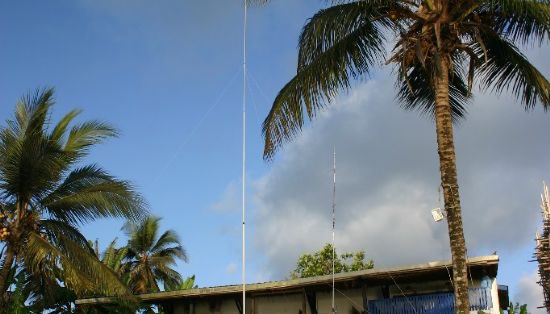Following their DXpedition to XZ (Myanmar) and 5Z (Kenya), DL7DF and colleagues activated Cameroon in October 2004, operating as TJ3FR and TJ3SP with most activity being on the low bands and on RTTY, PSK31 and SSTV.
The date of the DXpedition was 6th. – 20th Oct. 2004 and the operators were:
Manfred – DK1BT
Wolf – DL4WK
Reiner – DL7KL
Sigi – DL7DF
Frank – DL7UFR
Les – SP3DOI
They used the following equipment:
IC735, IC706, PA’s, Vertical Titanex V80E, Vertical for 40m, Verticalfor 30m, Beam A3WS, Beams for 20, 15 & 10m.
Further details can be found at: www.qsl.net/dl7df
BARTG is pleased to have been able to offer some sponsorship for this DXpedition.
Read the team’s report after the images below:
BARTG helped to support the DXpedition to Cameroon in 2004. Frank Rutter (DL7UFR) tells us his story and demonstrates very well ‘that if something can go wrong, it will’ but also that ‘amateur radio ingenuity’ will always find a way…….
During our DXpedition 3XY7C to Guinea in the Autumn of 2002 we talked about a possible new destination for a new DXpedition to Cameroon. We discussed this with our aid at that time – Khalil. Unfortunately Khalil could not help us with the procurement of radio permissions. Our own attempts failed in May 2003, when the authority for telecommunications in Cameroon told us that we need a domicile in Cameroon to get a radio permission. At the end of March 2004, we looked for a new destination for the DXpedition for this year and then we received some post from the authority for telecommunications in Cameroon. We were quite surprised, when we held the two license documents in the hands after opening the envelopes!
From now on the preparation for the DXpedition ran at full speed. The old contacts in Cameroon had to be refreshed. Also the reservation in the hotel could be re-activated. The members of the DXpedition team were also quickly found: Manfred – DK1BT, Wolfgang – DL4WK, Sigi – DL7DF and his XYL Sabine, Reiner – DL7KL and Frank – DL7UFR already members on the last DXpedition XZ7A to Myanmar. Only Leszek – SP3DOI was new this time. In the luggage a HEX Beam, two R7-Verticals, a Titanex V80E, a vertical antenna for the 30-Meter-Band, some wire for wire antennas and a beverage, two Transceivers – an ICOM IC735, two ICOM IC 706, two linear amplifiers TY900, one PACTOR CONTROLLER, five Notebooks and several hundred metres of coaxial cables, in addition to the personal items.
On October 6th we left from Berlin Tegel to Duala via Paris. The last step was from Duala to Kribi.
Cameroon borders in the northeast with Chad, in the east with the Central African Republic, in the south with the Congo, Gabon and Equatorial Guinea. The northwest and the west form the state border with Nigeria. From the heavy-rainfall coastal low country, with enormous jungles over the central highland up to the wild-like drying zones of the north the country cuts through the most diverse vegetation and climate zones.
Kribi, with approximately 30,000 inhabitants, lies directly in the delta of the river Kienké at the Atlantic. Kribi was created during the colonial age by the Germans, of which still today some buildings remind us of this historical past. The church and a lighthouse still originate from this time. For Germany the colonial age ended with the end of the First World War after a relatively short duration of 32 years.
After six and a half hours flying time we arrived at Duala. At the airport we met our aid Erika. We took a large bus for the last transport over a distance of 180 km to Kribi. What started in Berlin so well, should not end so well in Cameroon. We took the three antenna bags at first. Two suit-cases came also immediately. But two traveling bags were missing. In these were a quantity of small articles for completing the station, two SWR bridges and the MFJ Analyser. Also parts of the HEX Beams. The missing luggage stood – for safety reasons – for 24 hours at the Berlin Tegel airport.
It became soon dark and actually we wanted to reach Kribi still at daylight. It was not the condition of the roads. No, the roads until Kribi are asphalted and are in relatively good condition. There were vehicles, which were turned off without lighting at the roadside and/or drove without lighting in the dark on the road. At 22.00 we reached the New Coco Beach Hotel in Kribi, our location for the next two weeks. The area of the hotel was smaller than described in the travel guide. Finally we went to our rooms and met up at the dinner – it was not possible to even think about putting the antennas togehter in the dark!
The first sunlight on the following day gave enough light to look at the terrain more intensively. First, it was clear that the place for our antennas was not as big as we thought. At breakfast we made the first plan and hoped to be able to use the area belonging to the neighbours. On one of the neighbours ground a hotel was built. Nobody lives there – good to build up antennas … we thought. Unfortunately it was not a good idea as the land belonged o the highest general of Kribi. There was no possibility of using this area for our antennas. Without giving up this idea we began unpacking antennas.
The result of our first inspection of our luggage was the following: two luggage items were missing. We could complete two stations with linear amplifiers TY900. All the short cable connections between the linear amplifier and transceiver were missing, but wire and coax cable, naturally without plugs, replaced the PTT and the cable to the PA. To make the connections safe we used tape. The V80E was assembled fast, only missing all the screws and metal clips. No problem, cable strap solved the problem. The antenna for the Lowbands 80 and 160 m was ready for use in one hour. For 30m we used a glass fiber tower and a wire for a vertical. An R7 was completely available and quickly installed at the pool bar. Now we began with the first band observation. But these tests ended very fast. The plug sockets did not have a protective grounding and the system filters in the power supply meant that we had 110 V at the devices. We already knew the problem from other activities. With wire we made a connection to the water pipeline.
The prefabricated coaxial cables represented another problem. These were either too long, usually however too short. Since were missing the PL couplings, we decided to cut the PL plugs off and to connect the cables directly.
Also some cables between the Transceiver and Notebook were missing. We began the activity with SSB and RTTY. Our first band observation found that 12 m was open. Leszek could not wait for the first 12 m QSO’s while Manfred made the first QSOs on 15 m in RTTY. Leszek developed such an energy that we called him for the future the “SSB machine”. Sigi and Frank operated the station for the first night. On 80 m more than 500 QSOs came into the log. Only the QRN prevented a higher number of QSOs. Therefore we build up a 400 meters long beverage.
We had an even greater problem. By day and even in the night there were so many power failures. Many more than we had not experienced on other DXpeditions. At the beginning there were only short losses, because the emergency power diesel of the hotel started independently. Only starting the computers again and loading the logs took longer and longer as a resdult of the rising number of logged QSO’s. After a few days had we the first longer power failure. The starting battery of the emergency power Diesel was empty. The weekend stood before us and on Monday was holiday due to the elections in Cameroon. The battery charging station in the port was not open before Tuesday. But we should have luck. On the day of election there were no power failures.
After both traveling bags had arrived in the hotel we could now finally build up all the rest of the station. The HEX Beam found its place directly at the entrance to the hotel and looked probably for the locals rather like an oversize laundry spider! The second R7 was installed at the beach. All stations could alos now be provided with proper cables and plugs.
If we had only 2000 QSO’s per day in the first days, then now the number of QSO’s increased substantially. If the signals were piling up we used our “secret weapon”. Leszek fought each SSB pileup down. With a rising number of QSOs we began to activate also the digital modes. Thus 1921 QSOs in RTTY, 274 in PSK31 and 30 in SSTV came into the log.
On 80 and 160 m each night numerous QSO’s came into the log. The QRN became from day to day stronger. The stations called usually only once with their call. Due to the strong QRN it was not possible the get a call correctly unless stations called only one time. We told our Web masters Bernd, DF3CB, to publish in News on the homepage about that.
Already in the first days a phenomenon was noticeable to us. Around 18.00 UTC each day all bands closed. At the beginning we thought the receivers were broken. After the exchange of all four transceiver we knew that the receivers could not be broken. After one hour the bands were again open. Now it was also possible to work on 10 m with very loud signals to North America. From now on the hour between 18.00 and 19.00 UTC we transferred the log files into the Pactormailbox ZS5S. This mailbox has an internet gateway, so we could exchange our News and log files daily with Bernd, DF3CB. Bernd updated our homepage http://www.dl7df.com/tj3 during the DXpedition and maintained the online log. We would like to thank Bernd here.
Up to the end of the DXpedition we had approximately 34500 QSO’s in the log. Also the power failures continued right up to our departure at the airport in Duala. When paying the airport tax it was already dark and we had a power failure for a half hour. At this time there was no emergency lighting. This had to be the DXpedition with most power failures!
We would like to thank for their help and support Erika Massing and the personnel of the New Coco Beach hotel, which cared for us in the 14 days of our stay very well.

